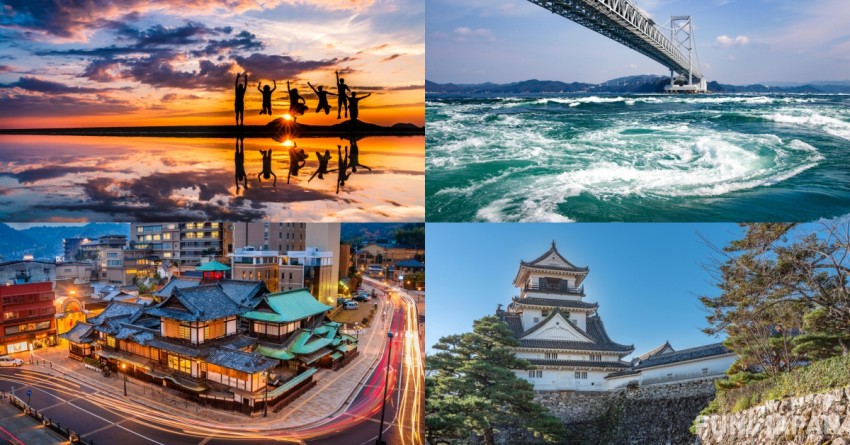
Shikoku region, located in the southwestern part of the Japanese archipelago, consists of four prefectures: Kagawa, Tokushima, Ehime, and Kochi.
From the breathtaking views created by nature, unique history and culture, to local gourmet... In this article, we have compiled the basic information of these four prefectures in Shikoku, as well as the classic tourist spots and gourmet food that you should know before visiting. With this guide, you won't be lost on your next trip to Shikoku!
※The information featured in this article is as of January 2024. Please check the official website or other sources for the latest information.
What are the four prefectures of the Shikoku region? Kagawa, Tokushima, Ehime, and Kochi as seen on the map
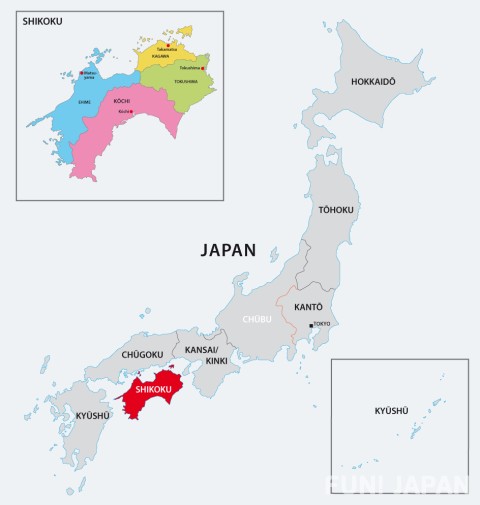
The Shikoku region, surrounded by the Seto Inland Sea and the Pacific Ocean, is located in the midst of the Japanese archipelago, surrounded by the Kansai region, the Chugoku region, and the Kyushu region. It is the smallest of the four main islands that make up the Japanese archipelago, consisting of the four prefectures of Kagawa, Tokushima, Kochi, and Ehime, clockwise from the top right. The name is said to have originated from the fact that there were once four lands - Sanuki (now: Kagawa), Awa (now: Tokushima), Iyo (now: Ehime), and Tosa (now: Kochi).
Main Means of Transportation to the Shikoku Region & Recommended Ways to Travel Around
As of January 2024, there are no direct flights to the Shikoku region from other countries, so it is common to transfer to a domestic flight from another prefecture, or travel to your destination by bus, train, or rental car from a nearby area.
| Kagawa Prefecture | Tokushima Prefecture | Ehime Prefecture | Kochi Prefecture | |
| Airport | Takamatsu Airport (TAK) | Tokushima Awa Odori Airport (TKS) | Matsuyama Airport (MYJ) | Kochi Ryoma Airport (KCZ) |
| Domestic flight routes | Chiba・Narita International Airport (NRT) Tokyo - Haneda Airport (HND) Okinawa - Naha Airport (OKA) | Tokyo - Haneda Airport (HND) Fukuoka - Fukuoka Airport (FUK) | Chiba - Narita International Airport (NRT) Tokyo - Haneda Airport (HND) Aichi - Chubu Centrair International Airport (NGO) Fukuoka - Fukuoka Airport (FUK) Okinawa - Naha Airport (OKA) etc. Total 9 routes | Chiba - Narita International Airport (NRT) Tokyo - Haneda Airport (HND) Osaka - Itami Airport (ITM) Fukuoka - Fukuoka Airport (FUK) etc. Total 7 routes |
| Travel time and standard fare to major railway stations | About 45 minutes to Takamatsu Station by Kotoden Bus | 1,000 yen | About 30 minutes to Tokushima Station by Limousine Bus | 600 yen | About 15 minutes to Matsuyama Station by Limousine Bus | 700 yen | 35 minutes to Kochi Station by Tosaden Kotsu Bus | 900 yen |
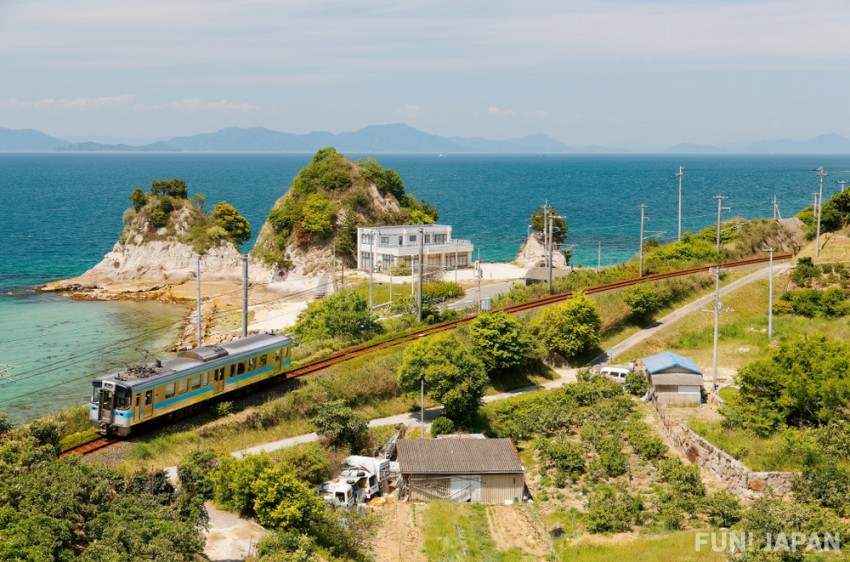
The Shinkansen does not run in the Shikoku region, and the main public transportation in the area is railways (limited express, rapid, local trains, etc.), buses, and trams. However, there are not as many services as in Tokyo or Osaka, and there are not a few tourist spots that are difficult to access by public transportation. If you want to tour multiple spots, it is efficient to use a rental car.
Explaining the classic tourist spots & exquisite gourmet food in Shikoku region by prefecture
Scenic views, hot springs, historical buildings... Shikoku region has a lot to see! From here, we will introduce three representative scenic spots and gourmet food in the four prefectures.
There are many photogenic spots popular on SNS in Kagawa Prefecture, the "Udon Prefecture"
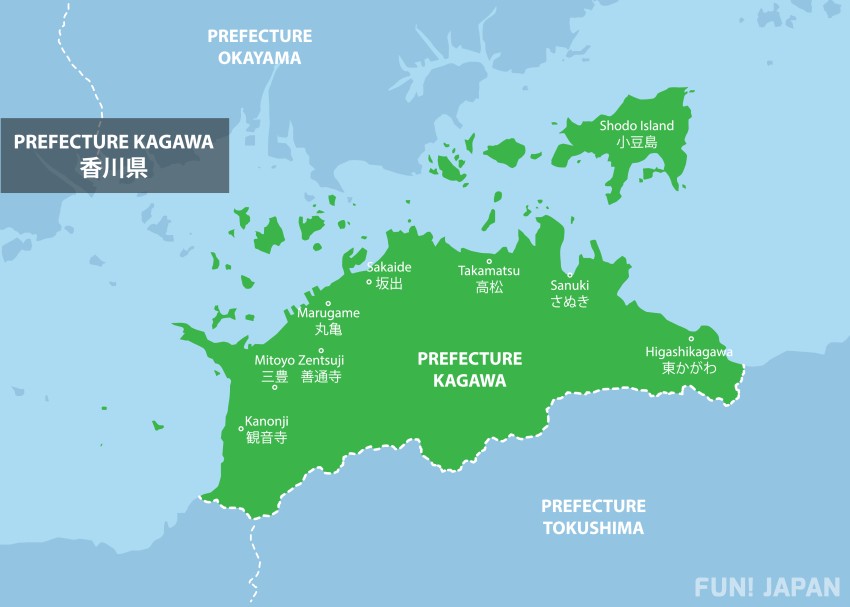
Located in the northeastern part of the Shikoku region, Kagawa is the smallest prefecture in Japan in terms of area. In addition to Takamatsu Airport (TAK), which mainly serves domestic flights from and to Tokyo Haneda Airport, the Seto Ohashi Bridge connects it to the Chugoku region and Okayama by land.
When touring Kagawa, it is convenient to make Takamatsu City, where sea and land transportation terminals such as JR Takamatsu Station and Takamatsu Port are concentrated, your base for travel.
【Shodoshima】Roadside Station Shodoshima Olive Park
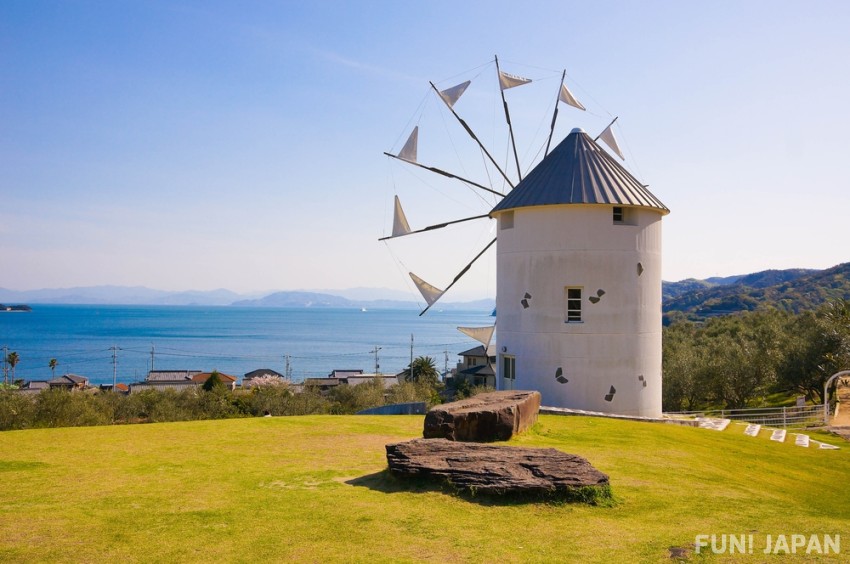
The "Roadside Station Shodoshima Olive Park" is home to about 2,000 olive groves, a herb garden greenhouse, a cafe & restaurant, and hot spring facilities.
In the general store using the location set of the movie "Kiki's Delivery Service", you can experience the world of Studio Ghibli movies. It is a standard to take a picture of flying on a magic broom that can be rented for free against the backdrop of the "Greek windmill" on a hill overlooking the Seto Inland Sea.
- Address: 1941-1 Nishimura Kō, Shodoshima-cho, Shōzu-gun
- Access: About 35 minutes from Takamatsu Port to Shodoshima (Tonosho Port) by Shodoshima Ferry (high-speed boat). About 30 minutes by bus from Tonosho Port to "Olive Park Entrance" bus stop, about 5 minutes walk after getting off
*Access is also possible from several other ports - Official website: https://www.olive-pk.jp/
【Mitoyo City】Chichibugahama
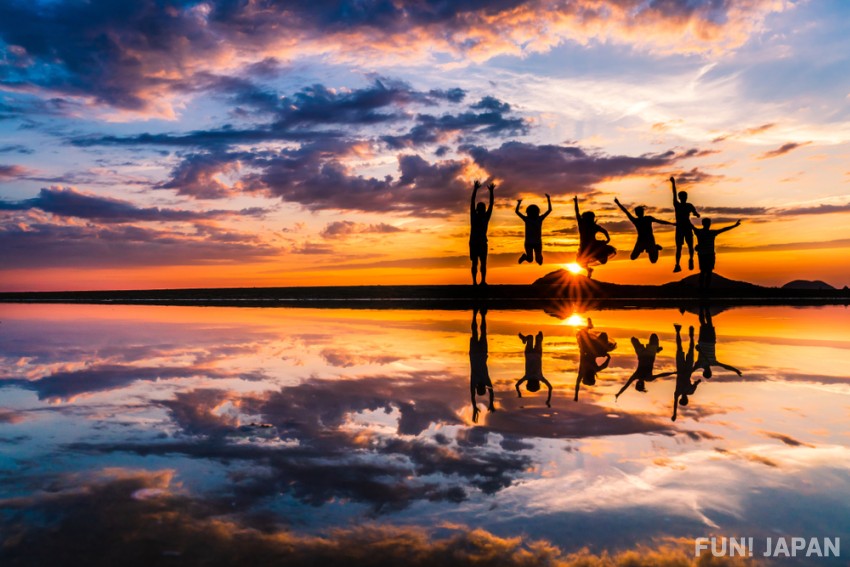
The 'Chichibuga Beach' stretches for 1km of sandy shore. During calm, low tide, the water surface reflects like a mirror, creating a scene reminiscent of the Uyuni Salt Flats in Bolivia.
Recently, it has become a hot topic on social media as a photogenic spot where you can take pictures like a "mirror in the sky". Let's take a fantastic photo of a person reflected in a tide pool with the sunset, which has been selected as one of the "100 Best Sunsets in Japan".
- Address: 203-3 Nio Otsu, Niocho, Mitoyo City
- Access: About 20 minutes by community bus from JR Takuma Station
- Official Website: https://www.mitoyo-kanko.com/chichibugahama/
【Throughout Kagawa Prefecture】Sanuki Udon
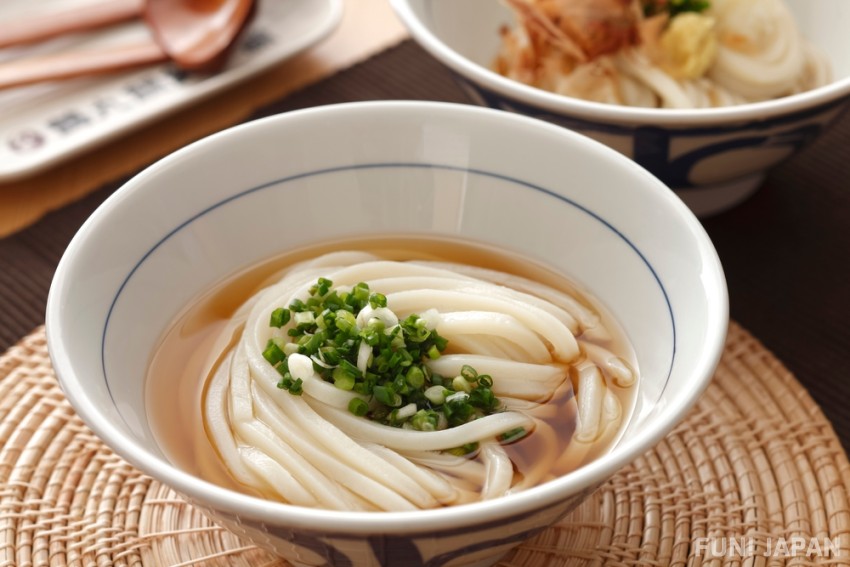
Known as the "Udon Prefecture", Sanuki Udon is a symbol of Kagawa. There are udon shops all over the prefecture, where you can enjoy noodles with a firm texture and a light broth.
The typical way to eat it is to pour broth over it and top it with green onions or tempura bits for a simple Kake Udon, or pour a thick dipping sauce over the udon for Bukkake Udon. Try finding your own way to arrange it with toppings like tempura or eggs.
There's more to see in Kagawa Prefecture!
- Guide to Kagawa Prefecture in Shikoku Island, Japan
- Unveiling a New Japan, Captivating Experiences — a four-day, three-night itinerary for the Setouchi area: make teuchi udon noodles from scratch, try your hand at SUP on clear open waters and lose yourself in culture, history and nature.
- A Look at the Beautiful Stone Walls of Marugame Castle
- Let's Go to Naoshima, Japan's Art Island! Home of the Setouchi Triennale Art Fest!
A Journey to Tokushima Prefecture to Experience the Great Outdoors and Awa Odori
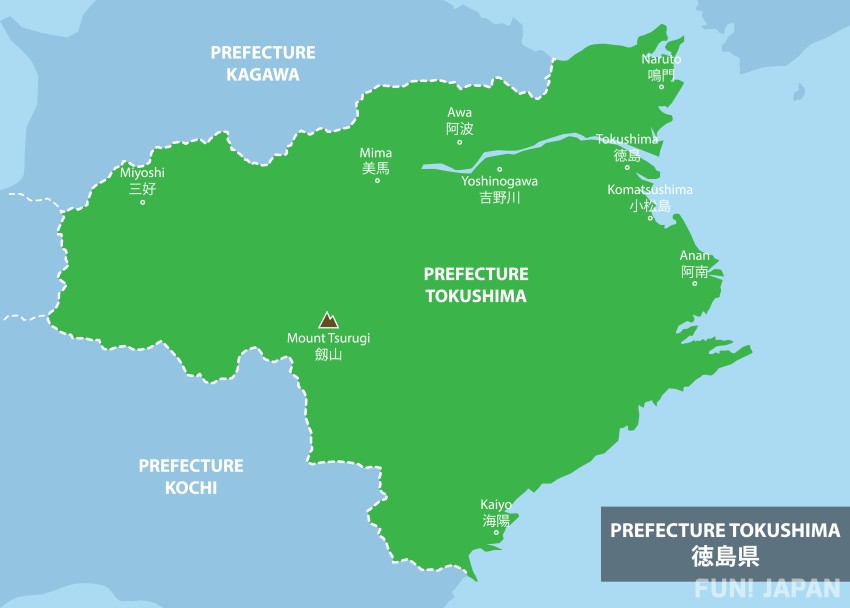
Located in the eastern part of Shikoku, Tokushima is a prefecture where mountains cover about 80% of its area. It is connected to Hyogo and Awaji Island by Onaruto Bridge, and is within a day trip distance from Osaka and Hyogo, playing a role in connecting with the Kansai area. When touring within the prefecture, it is recommended to make the area around Tokushima City and JR Tokushima Station, which are easily accessible to downtown and various tourist spots, the base of your trip.
【Naruto City】Naruto Whirlpools (Onaruto Bridge Promenade Uzu no Michi & Whirlpool Sightseeing Boat)
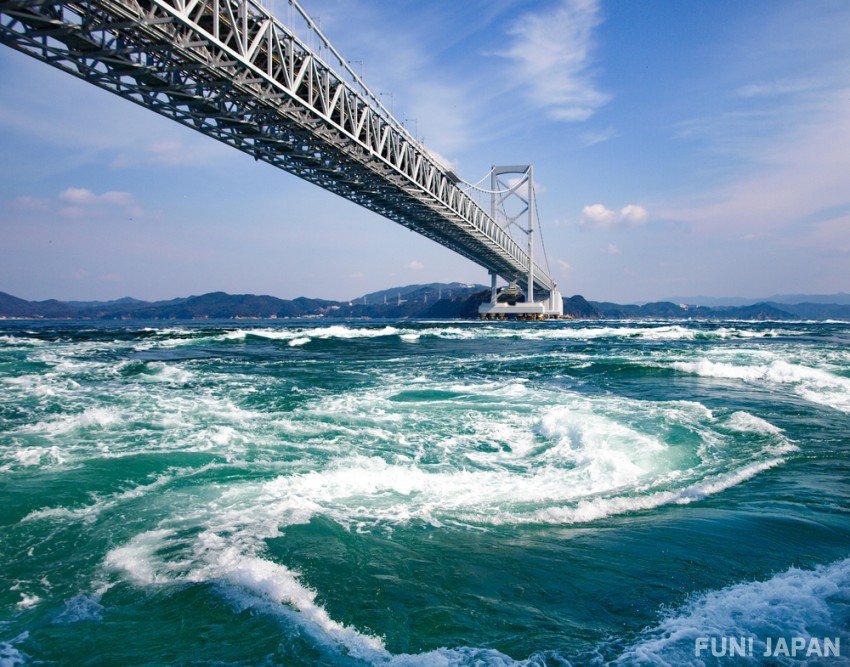
The "Naruto Strait Whirlpools", seen between Tokushima's Naruto City and Hyogo's Awaji Island, is one of the world's three major tidal currents created by the difference in the ebb and flow of the tide. Those that occur during the spring and autumn tides can reach diameters of over 20m.
You can experience the powerful whirlpools either from above at the "Onaruto Bridge Promenade Uzu no Michi" where you can see the whirlpools directly below, or from the "Whirlpool Sightseeing Boat" where you can observe them from a close distance on the sea.
- Address: Narutocho, Naruto City (within Naruto Park)
- Access: About 25 minutes by Tokushima Bus from JR Naruto Station to "Naruto Park" bus stop, then a 5-minute walk
- Official Website: https://www.uzunomichi.jp/
【Miyoshi City】Oboke Koboke
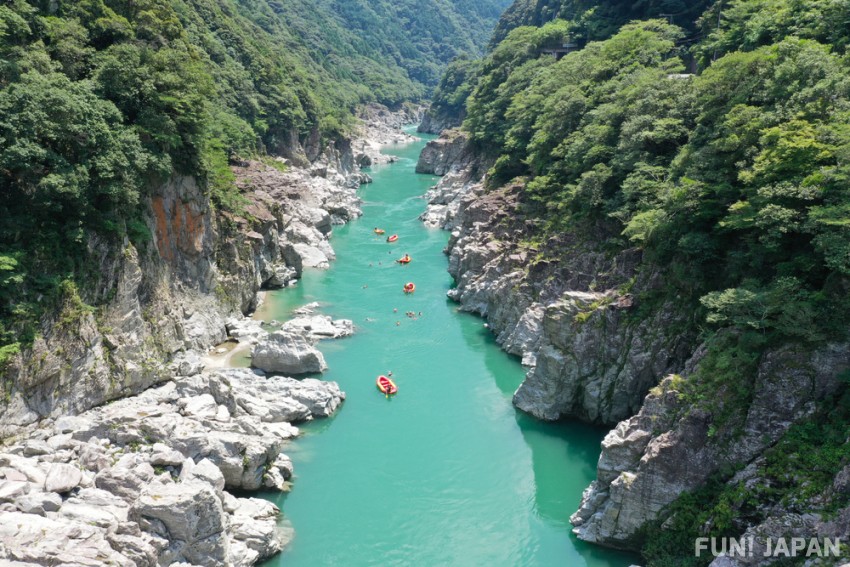
The "Oboke Koboke", designated as a historic site, scenic spot, and natural monument. Over the course of more than 200 million years, this approximately 8km stretch of blue-gray boulders and strange rocks has been eroded by raging currents, allowing you to enjoy the original landscape of each season.
Why not find your favorite angle by looking out over the valley beauty from the observation deck, or experiencing the Oboke Gorge sightseeing cruise, which takes about 30 minutes to descend the Yoshino River?
- Address: From Shigemi to Kamina, Yamashiro-cho, Miyoshi City
- Access: About 5 minutes by Shikoku Kotsu Bus from JR Oboke Station to "Oboke Gorge" bus stop
- Official Website: https://miyoshi-tourism.jp/spot/oobokekyo-kobokekyo/
【Throughout Tokushima Prefecture】Awa Odori
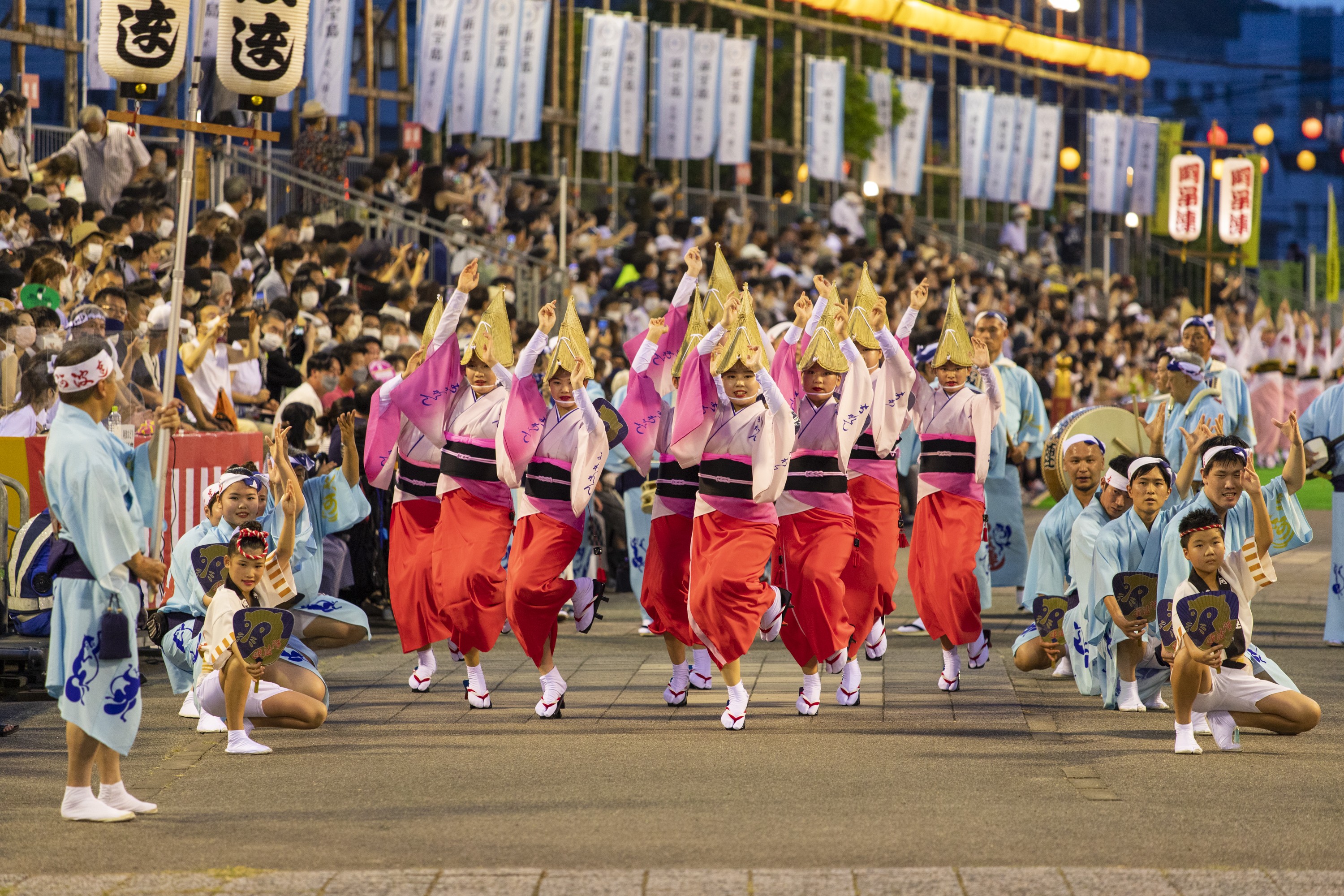
The "Awa Odori", one of Japan's three major Bon dances, is a traditional performing art with a history of over 400 years. Although it is held in various parts of the prefecture during the summer, the one held in the center of Tokushima City from August 12th to 15th every year attracts over one million tourists from both inside and outside the country.
During the festival, men dance in happi (short coats worn at festivals), while women dance in colorful kimonos and straw hats. The sounds of shamisen, drums, and flutes can be heard from all over the town, and groups of dancers called "ren" parade around.
- Address: Downtown Tokushima City, etc.
- Official Website: https://www.city.tokushima.tokushima.jp/kankou/awaodori/
There's more to see in Tokushima Prefecture!
- Where is the Spectacular Iya Valley in Japan?
- Where are the Power Spots in Mount Tsurugi? Let's Find them Out!
- Iya Kazurabashi Bridge where Legends of Monsters and Ghosts Live on
Did you know Ehime Prefecture is home to the model location for "Spirited Away"? Pay attention to Dogo Onsen and mandarin oranges!
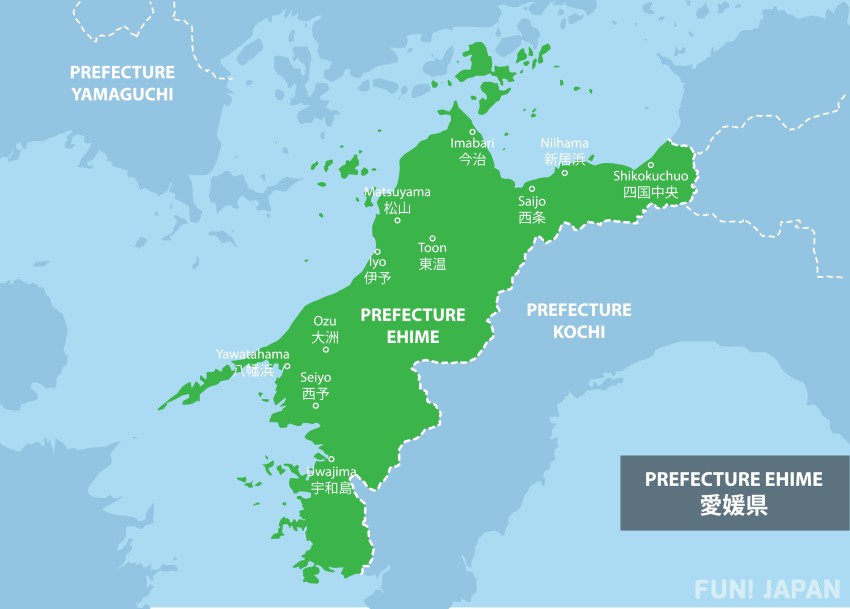
Ehime, which borders the two prefectures of Kagawa and Tokushima on the east, is the prefecture where Matsuyama City, which has the largest population in the Shikoku region, is located. It is characterized by the short distance between the airport and the city center in the Shikoku region, with a limousine bus from Matsuyama Airport (MYJ) to Matsuyama Station taking about 15 minutes.
Also, the Chugoku region and Hiroshima are connected by the "Shimanami Kaido", a sea route spanning about 60km. The route includes not only a highway but also a path for bicycles and pedestrians, attracting many tourists who travel between Honshu and Shikoku by bicycle.
【Matsuyama City】Dogo Onsen
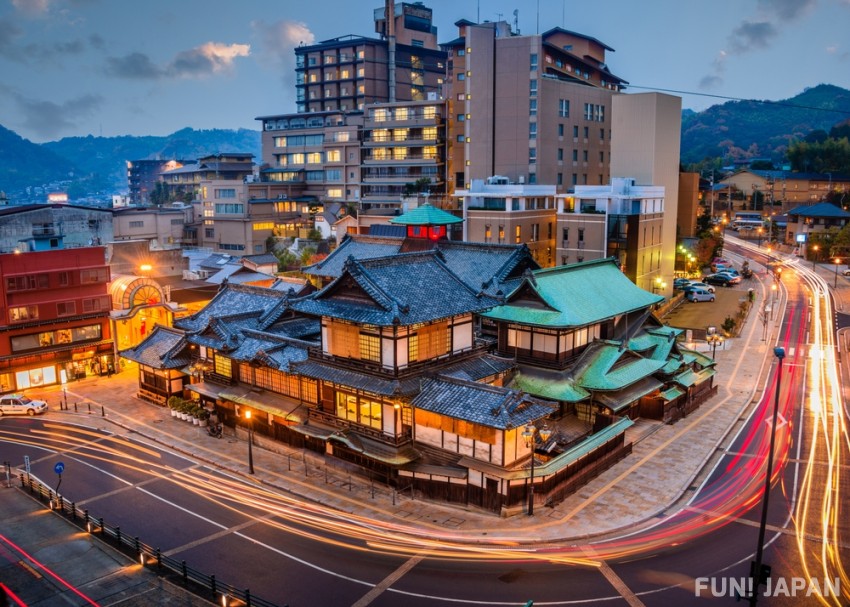
It is said that the history of "Dogo Onsen", considered the oldest hot spring in Japan, spans over 3,000 years. It has long been popular as a "beauty hot spring" for its gentle touch on the skin and smooth texture.
There are three hot springs: "Dogo Onsen Honkan※", "Dogo Onsen Annex Asuka no Yu" and "Dogo Onsen Tsubaki no Yu". Among them, the main building, built in 1894, is designated as an important cultural property of the country, and it is said to have been the model for the bathhouse that appears in Studio Ghibli's "Spirited Away".
※Preservation repair work is being carried out until December 2024. The entire building is scheduled to reopen in July 2024.
- Address: Dogo Yunomachi, Matsuyama City
- Access: About 5 minutes on foot from JR Dogo Onsen Station
- Official Website: https://dogo.jp/
【Imabari City】Shimanami Kaido
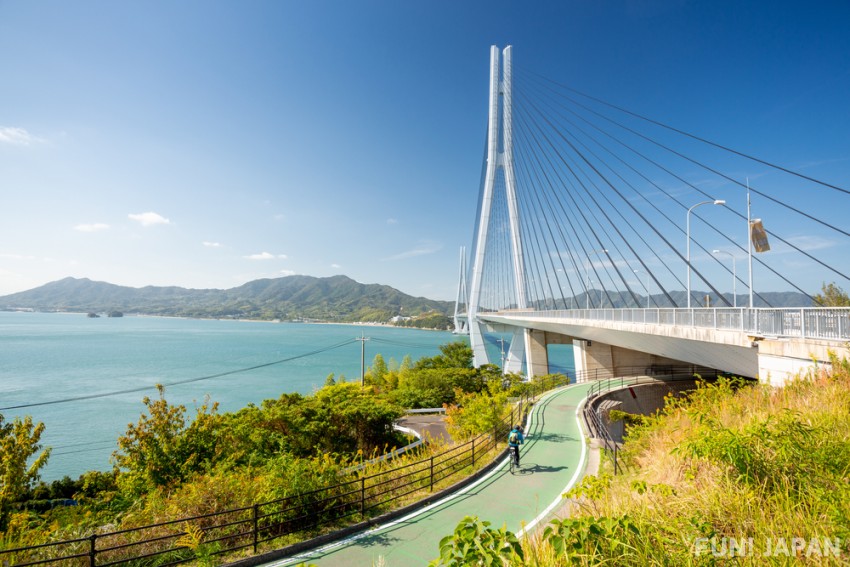
The "Shimanami Kaido", a series of bridges connecting the islands of the Seto Inland Sea from Onomichi City in Hiroshima to Imabari City in Ehime. With facilities scattered around where you can rent bicycles and well-maintained cycling courses, it is gaining attention as a "sacred place for cyclists".
Along the way, there are plenty of tourist spots such as roadside stations, parks, and shrines, and you can enjoy various local gourmet foods.
- Address: Onomichi City, Hiroshima Prefecture to Imabari City, Ehime Prefecture
- Official Website: https://www.jb-honshi.co.jp/shimanami/
【All over Ehime Prefecture】Mikan & other specialty products and souvenirs (juices, jellies, jams, etc.)
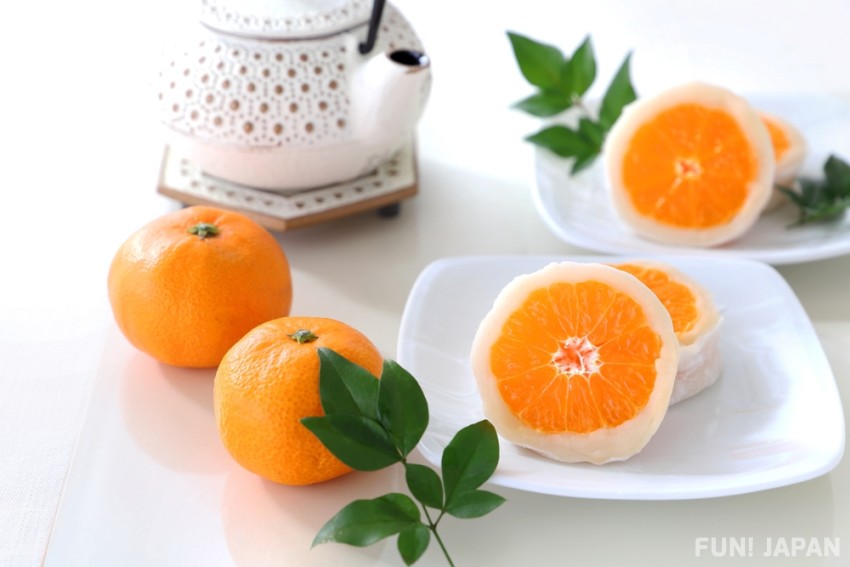
Ehime, also known as the "Citrus Kingdom", is known as one of Japan's leading producers of mandarins (mikan). Many mandarins with a rich taste balanced in sweetness and acidity are produced, and they are delicious to eat as they are. Specialty products such as sweets, juices, jams, and jellies are also perfect for souvenirs.
There are other tourist attractions in Ehime!
- The Best 10 Attractions in Ehime, Japan
- 【Japan's Famous Castle Series】"Ozu Castle", the miracle castle of Ehime Prefecture - the wooden castle tower has been completely restored!
- Ehime Prefecture is Filled with #1s in Japan!
- 【Japanese Gourmet】Affordable Local Gourmet Foods Pilgrimage: "Ehime" Edition
- 5 Must-Experience Things in Matsuyama City Filled with Japanese Good Old Days’ Atmosphere
- 3 Hidden Spots We Want to Capture on Film at Matsuyama Castle in Japan
- Uwajima Castle in Japan, with a history of over 400 years
Kochi Prefecture, where Ryoma Sakamoto was born, is a treasure trove of historical culture and superb views!
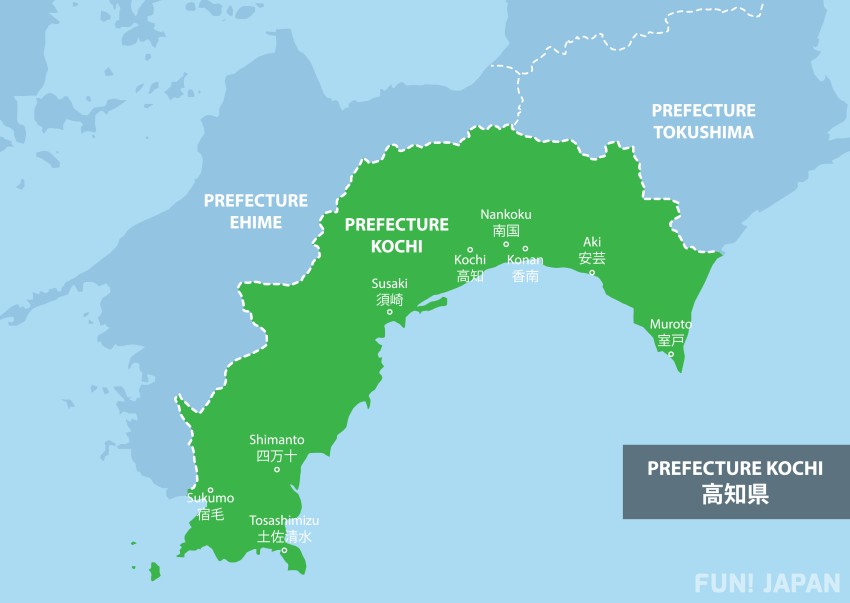
Located in the southwest of the Shikoku region, facing the Pacific Ocean to the south and the Shikoku Mountains to the north, is Kochi. As there are no international flights to Kochi Ryoma Airport (KCZ), it is common to access it from outside the prefecture via domestic flights, express trains, or high-speed buses.
In the prefecture, the main means of transportation are the JR line, trams (Tosaden Kotsu), and buses. Kochi City, the birthplace of Sakamoto Ryoma who played an active role in the transition period from the Edo era to the modern era - the Meiji Restoration, has JR Kochi Station and a bus terminal, with many trains and buses departing and arriving from the airport and inside and outside the prefecture.
【Kochi City】Kochi Castle・Kochi Park
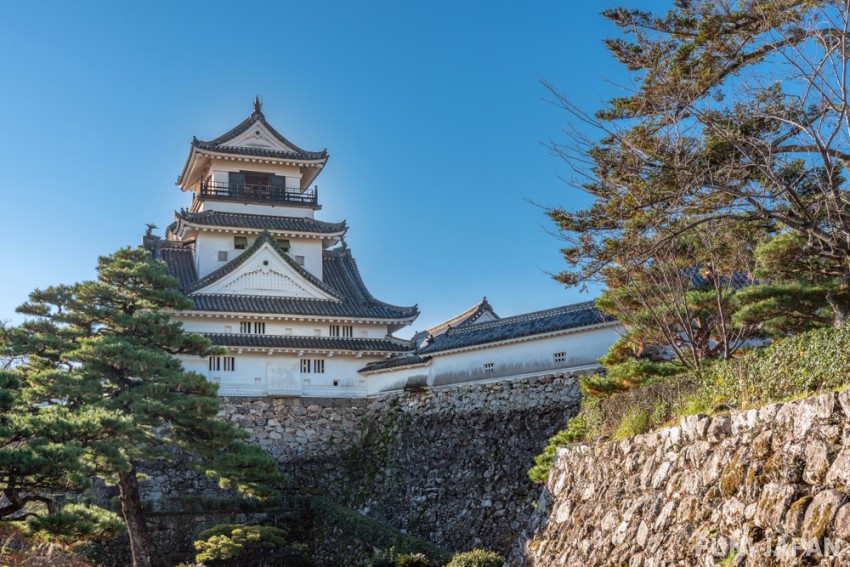
The "Kochi Castle", a landmark of Kochi, is the only castle in Japan where the entire main enclosure (hon maru), including the castle tower and palace, still exists. Although most of the buildings were destroyed by a fire in 1727, it was rebuilt in its original form from the Edo period and is called "the best castle in Nankaido".
After touring the three-story roofed, six-story castle tower and the Otemon gate, which are designated as important cultural properties of the country, it is recommended to take a walk in Kochi Park, which is centered around Kochi Castle. In spring, cherry blossoms and in autumn, autumn leaves, show a beautiful performance with the castle all year round.
- Address: 1 Marunouchi, Kochi City
- Access: About 10 minutes by Tosaden Kotsu bus from JR Kochi Station to "Kochi Castle Mae" bus stop, then a short walk
- Official Website: https://kochipark.jp/kochijyo/
【Shimanto City】Shimanto River, Submersible Bridge
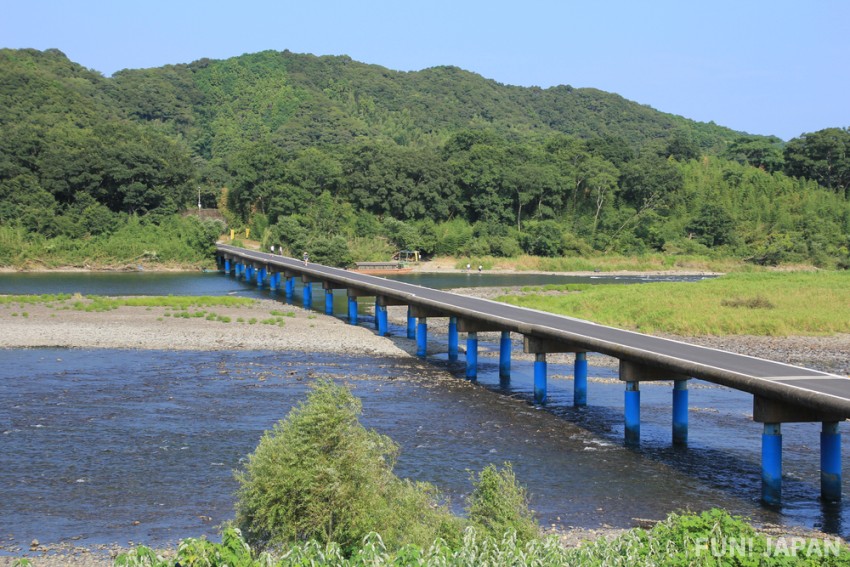
The "Shimanto River", known as "Japan's last clear stream", captivates people with its beautiful scenery and high water clarity. In the surrounding area, you can enjoy various activities such as canoeing, SUP experiences, and houseboat rides, regardless of age.
The "Submersible Bridge" (Chinkabashi), designed to sink to reduce water resistance when the river floods, is also a specialty. Dozens of submersible bridges are built on the main stream and tributaries, among which the approximately 291.6m long submersible bridge "Sada Submersible Bridge (Imanari Bridge)" is very popular.
- Address: 【Sada Submersible Bridge (Imanari Bridge)】1-20-1, Kabukicho, Shinjuku-ku, Tokyo
- Access: 15 minutes by car from JR Nakamura Station
【Throughout Kochi Prefecture】Bonito dishes (Tataki, Straw-grilled, Sashimi, etc.)
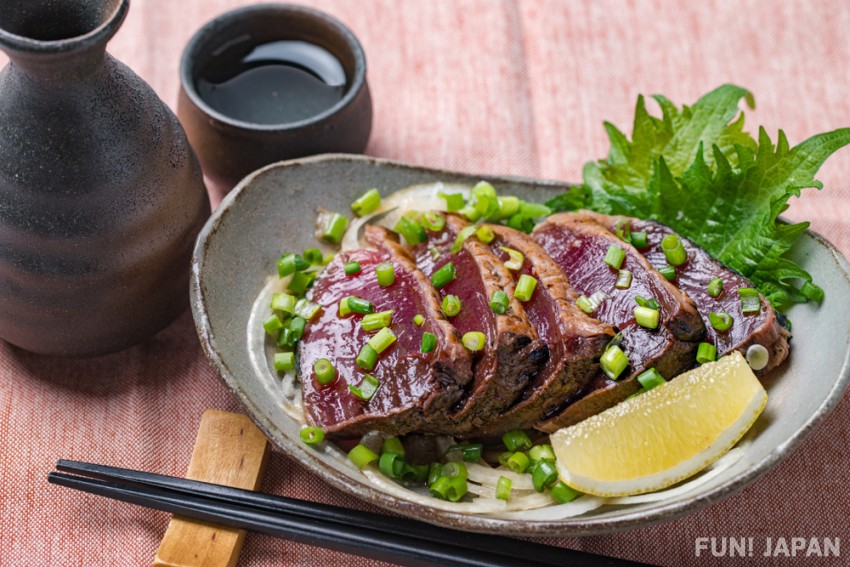
In Kochi, famous for having the highest consumption of bonito in Japan, there are many restaurants that serve dishes using bonito. While popular ways to eat it include changing the condiments or sprinkling salt instead of sauce, there are also many fans of tataki, where the surface of the bonito is grilled with burning straw and served with condiments such as green onions and myoga in sauce.
The bonito caught in Kochi is in season in spring to early summer (around March to May) and in autumn (around September to November). The taste and the way the fat is on are different, so please try and compare them.
There are other tourist attractions in Kochi Prefecture!
- Kochi: The Prefecture with Best Forest in Japan
- Katsurahama in Kochi is Not just a Beach! 3 Recommended Places
How many nights are recommended to fully enjoy the Shikoku region?
The Shikoku region is full of tourist content such as nature, culture, history, and gourmet. If you have 4 nights and 5 days, you can go around all 4 prefectures, but in that case, most of the time will be taken up by travel, so plan your trip to stay for about a week. If you can only stay for a short period of time, focus on sightseeing in 1-2 prefectures.

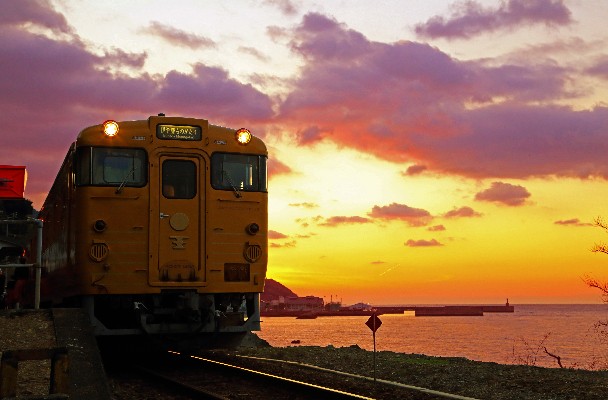
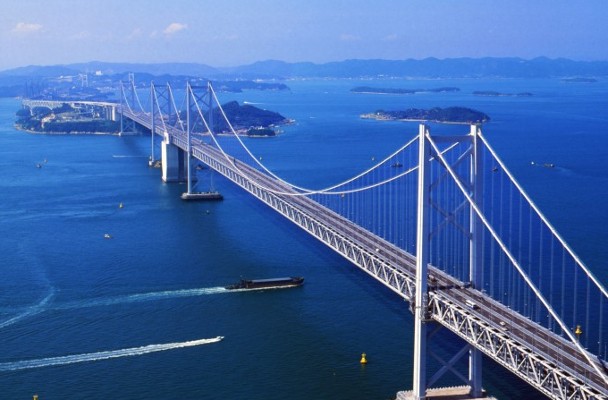
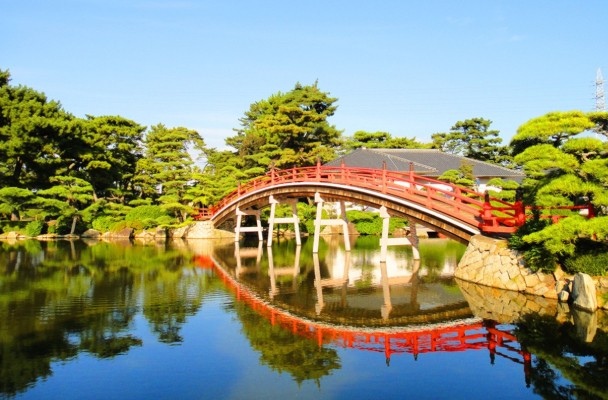
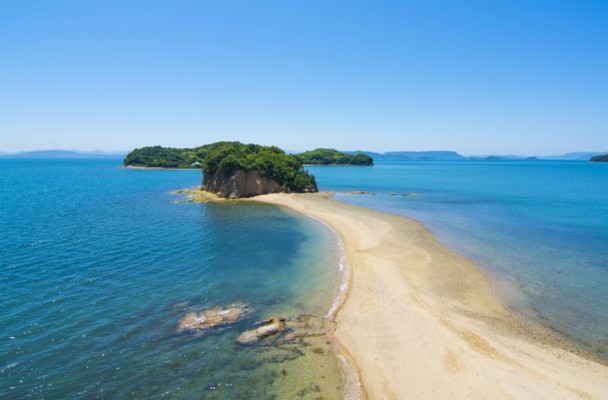
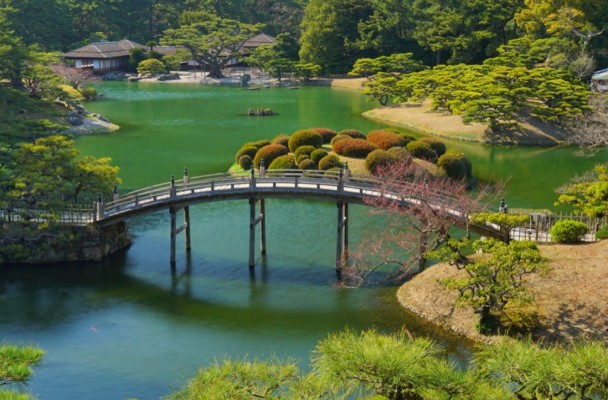
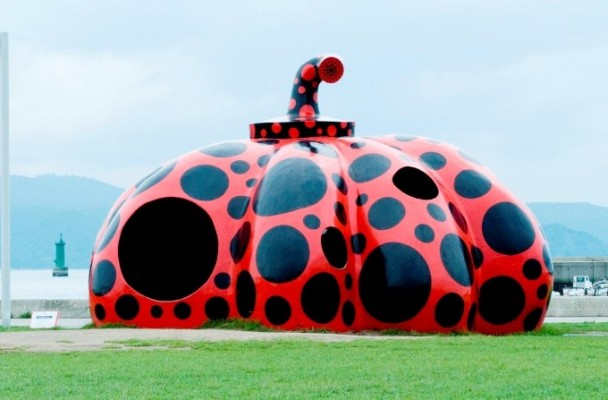

Comments